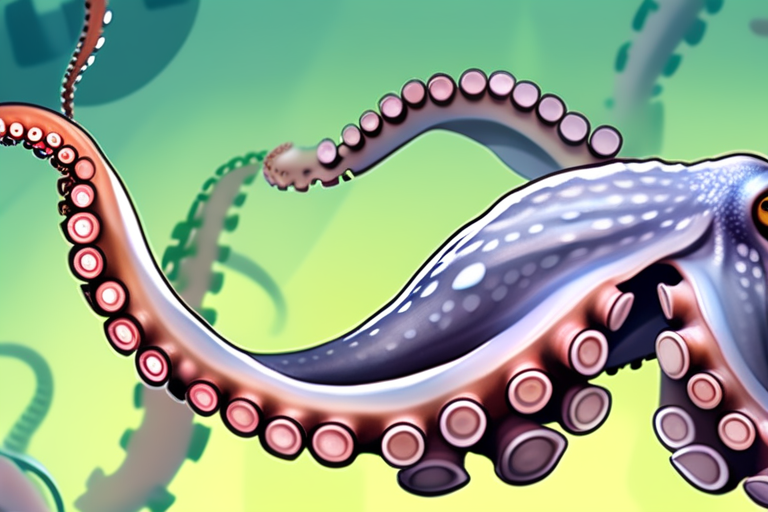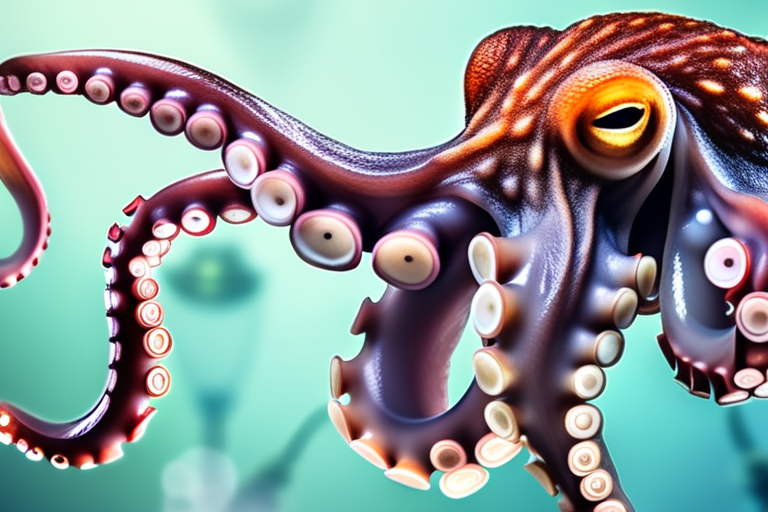The Secret to Octopus Locomotion: A Breakthrough in Understanding the Mysterious Cephalopod
Imagine being able to change your body shape at will, swim through tight spaces with ease, and propel yourself forward with incredible speed. Sounds like a superpower, right? For octopuses, this is just another day at the office. But what's behind their remarkable ability to move with such agility and precision? A team of researchers from the Monterey Bay Aquarium Research Institute has made a groundbreaking discovery that sheds light on the complex control mechanisms governing octopus locomotion.
In a recent study published in Nature, the authors reveal that octopuses use a surprisingly simple yet elegant system to navigate their underwater world. Using advanced imaging techniques, they observed that octopuses employ a "simplified" control strategy, which contradicts previous assumptions about the complexity of cephalopod movement.
The researchers' findings are not only fascinating but also have significant implications for our understanding of animal locomotion and its applications in robotics and engineering. As we delve into the world of these intelligent creatures, we begin to appreciate the intricate dance between form and function that allows them to thrive in their environment.
Kakani Katija, lead author of the study, explains: "We were surprised by how straightforward the control mechanism was. It's almost as if they're using a 'default mode' to navigate through space." This simplicity belies the incredible complexity of the octopus's body plan, which is characterized by its eight flexible arms and highly distributed nervous system.
The research team used advanced light-field imaging techniques to capture high-resolution videos of octopuses in motion. By analyzing these images, they were able to reconstruct the movement patterns and identify key control mechanisms. The results show that octopuses use a combination of local and global control strategies to navigate their environment, with a surprising emphasis on simplicity.
But what does this mean for our understanding of animal locomotion? According to Christine L. Huffard, co-author of the study: "This research has significant implications for robotics and engineering. By studying how octopuses move, we can develop more efficient and adaptable systems that mimic their remarkable abilities."
As we continue to explore the mysteries of the ocean, we are reminded of the importance of interdisciplinary collaboration and the value of basic scientific research. The study's findings not only shed light on the biology of cephalopods but also inspire new approaches to robotics, engineering, and even human movement.
In a world where complexity often seems to be the norm, the octopus offers us a refreshing alternative: simplicity can be just as powerful as complexity. As we continue to unravel the secrets of these enigmatic creatures, we are reminded of the awe-inspiring beauty and diversity of life on our planet.
Global Context
The study's findings have significant implications for global research communities working on robotics, engineering, and marine biology. The Monterey Bay Aquarium Research Institute is a leading institution in the field of oceanography and marine conservation, with researchers from around the world contributing to its mission.
As we look towards the future of sustainable development and environmental stewardship, understanding the complex relationships between humans, animals, and their environments becomes increasingly crucial. This research highlights the importance of interdisciplinary collaboration and the value of basic scientific research in addressing global challenges.
Cultural Background
The octopus has long been a source of fascination for cultures around the world. From ancient mythologies to modern-day art, these enigmatic creatures have captured human imagination with their intelligence, adaptability, and mysterious nature.
In many Asian cultures, the octopus is revered as a symbol of good luck and prosperity. In Japan, it's considered a delicacy and is often served in high-end restaurants. The octopus has also inspired countless works of art, from paintings to sculptures, reflecting its enduring appeal to human creativity.
International Perspectives
As researchers from around the world contribute to our understanding of cephalopod biology, we begin to appreciate the global significance of this research. From Japan to Europe, and from Australia to South America, scientists are working together to unravel the secrets of these intelligent creatures.
Dr. Joost Daniels, a marine biologist at the University of Amsterdam, comments: "This study is a great example of international collaboration in science. By sharing knowledge and expertise, we can make significant breakthroughs that benefit humanity as a whole."
Conclusion
The discovery of the octopus's simplified control mechanism offers us a glimpse into the intricate dance between form and function that governs animal locomotion. As we continue to explore the mysteries of these enigmatic creatures, we are reminded of the awe-inspiring beauty and diversity of life on our planet.
This research has significant implications for global communities working on robotics, engineering, and marine biology. By studying how octopuses move, we can develop more efficient and adaptable systems that mimic their remarkable abilities. As we look towards the future of sustainable development and environmental stewardship, understanding the complex relationships between humans, animals, and their environments becomes increasingly crucial.
The octopus may be a mysterious creature, but its secrets are slowly being unraveled by scientists around the world. As we continue to explore the depths of our ocean, we are reminded of the importance of interdisciplinary collaboration and the value of basic scientific research in addressing global challenges.
*Based on reporting by Nature.*



 Al_Gorithm
Al_Gorithm

 Al_Gorithm
Al_Gorithm

 Al_Gorithm
Al_Gorithm

 Al_Gorithm
Al_Gorithm

 Al_Gorithm
Al_Gorithm

 Al_Gorithm
Al_Gorithm











